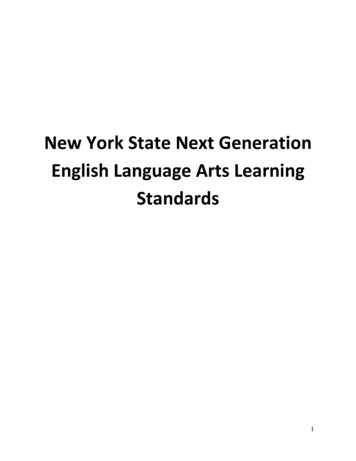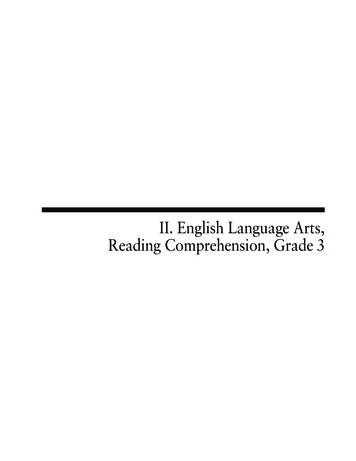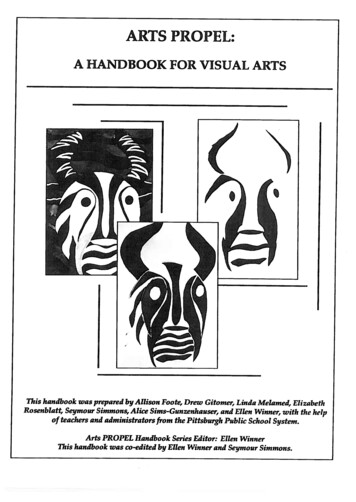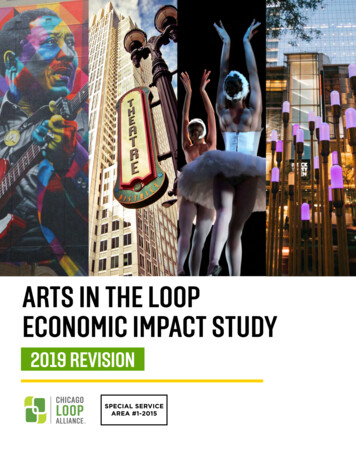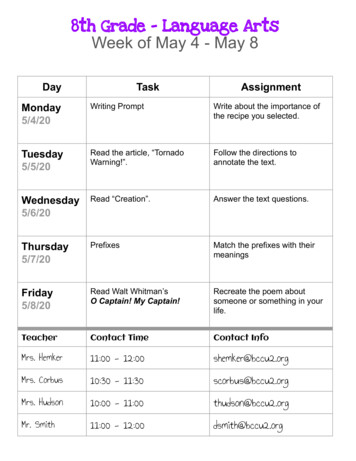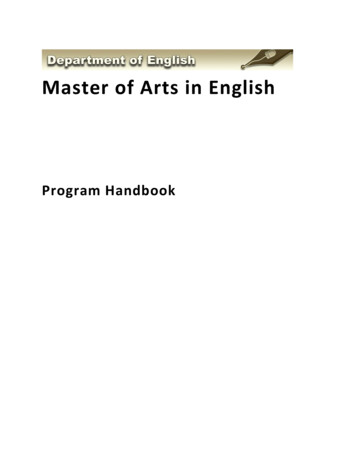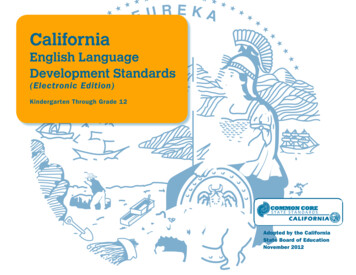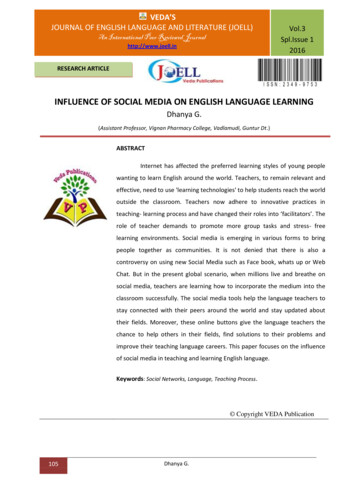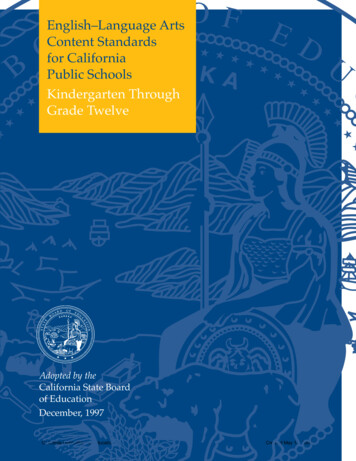
Transcription
BDRAEnglish–Language ArtsContent Standardsfor CaliforniaPublic SchoolsOO FEDCKindergarten ThroughGrade TwelveAdopted by theCalifornia State Boardof EducationDecember, 1997California Department of EducationUCreated May 18, 2000
English–Language ArtsContent Standardsfor CaliforniaPublic SchoolsKindergarten ThroughGrade TwelveCalifornia Department of EducationCreated May 18, 2000
Publishing InformationWhen the English–Language Arts Content Standards for California Public Schools, KindergartenThrough Grade Twelve was adopted by the California State Board of Education on November 14,1997, the members of the State Board were the following: Yvonne W. Larsen, President; Jerry Hume,Vice-President; Kathryn Dronenburg; Marion Joseph; Megan Kephart; S. William Malkasian;Marion McDowell; Janet G. Nicholas; Gerti B. Thomas; Robert L. Trigg; and Marina Tse.This publication was edited by Faye Ong, working in cooperation with Greg Geeting, AssistantExecutive Director, State Board of Education. It was designed and prepared for printing by the staffof CDE Press, with the cover and interior design created and prepared by Cheryl McDonald.Typesetting was done by Jeanette Reyes. It was published by the California Department of Education,1430 N Street, Sacramento, CA 95814-5901. It was distributed under the provisions of the LibraryDistribution Act and Government Code Section 11096. 1998 by the California Department of EducationAll rights reservedISBN 0-8011-1389-9Special AcknowledgmentThe State Board of Education extends its appreciation to the members and staff of the Commissionfor the Establishment of Academic Content and Performance Standards (Academic StandardsCommission) for their outstanding work in developing and recommending the English-language artscontent standards to the State Board of Education under the provisions of Education Code Section60605. The members and staff of the Academic Standards Commission at the time of the approvalof the draft English-language arts content standards were the following:Ellen Wright, Chair*; Bob Calfee, Vice Chair*; Joseph Carrabino; Judy Codding; Dan Condron;John D’Amelio*; Linda Davis; Bill Evers; Andrew Galef; Jerilyn Harris; Dorothy Jue Lee*; MarkOrtiz; Judy Panton*; Raymund Paredes*; Alice Petrossian*; Kate Simpson*; Lawrence Siskind*;Larry Stupski; Jerry Treadway*; LaTanya Wright*; and Superintendent of Public Instruction DelaineEastin and her designee, Sonia Hernandez.Note: The asterisk (*) identifies those members who served on the Academic StandardsCommission’s English-Language Arts Committee.Special commendation is also extended to the leadership of Ellen Wright, Chair of the AcademicStandards Commission; Scott Hill, Executive Director; Commissioner Alice Petrossian, Chair of theEnglish-Language Arts Committee; and State Board of Education members Kathryn Dronenburgand Marion Joseph, whose significant contributions to the English-Language Arts ad-hoc committeedeserve special recognition.Ordering InformationCopies of this publication are available for 12.50 each, plus shipping and handling charges.California residents are charged sales tax. Orders may be sent to CDE Press, Sales Office, CaliforniaDepartment of Education, 1430 N Street, Suite 3207, Sacramento, CA 95814-5901, FAX (916) 323 0823. See page 86 for complete information on payment, including credit card purchases, and an orderblank. Prices on all publications are subject to change.A partial list of other educational resources available from the Department appears on page 85. Inaddition, an illustrated catalog describing publications, videos, and other instructional media availablefrom the Department can be obtained without charge by writing to the address given above or bycalling the Sales Office at (916) 445-1260.NoticeThe guidance in English–Language Arts Content Standards for California Public Schools is notbinding on local educational agencies or other entities. Except for the statutes, regulations, and courtdecisions that are referenced herein, the document is exemplary, and compliance with it is notmandatory. (See Education Code Section 33308.5.)iiCalifornia Department of EducationCreated May 18, 2000
ContentsA Message from the State Board of Education and the State Superintendentof Public Instruction . ivIntroduction . vKindergarten . 1Grade One . 6Grade Two . 11Grade Three . 16Grade Four . 21Grade Five . 28Grade Six . 35Grade Seven . 42Grade Eight . 49Grades Nine and Ten . 56Grades Eleven and Twelve . 66Glossary . 76Selected References . 84iiiCalifornia Department of EducationCreated May 18, 2000
A Message from the State Board of Education and theState Superintendent of Public InstructionWith the adoption of these English–language artscontent standards in 1997, California set forth for thefirst time a uniform and specific vision of whatstudents should know and be able to do in this subjectarea. Reflecting a strong consensus among educators,these standards establish high expectations for allstudents. They embody our collective hope that allstudents become effective language users so that theycan succeed academically, pursue higher education,find challenging and rewarding work, participate inour democracy as informed citizens, appreciate andcontribute to our culture, and pursue their own goalsand interests throughout their lives.Standards create a vision of a comprehensivelanguage arts program.Before the creation of content standards, schoolreform efforts were guided by the desire to improvestudent achievement without agreement as to thecontent of that achievement. These standards set forththe content that students need to acquire by gradelevel. At every grade level the standards coverreading, writing, written and oral English languageconventions, and listening and speaking. Grade bygrade, the standards create a vision of a balanced andcomprehensive language arts program.Knowledge acquisition is a partof literacy development.Reading, writing, listening, and speaking arerelated processes, which should be nurtured within arich core curriculum. Literacy competencies are thegateways to knowledge across the disciplines. Priorknowledge is the strongest predictor of a student’sability to make inferences about text, and writingabout content helps students acquire knowledge.Thus, literacy and the acquisition of knowledge areinextricably connected. Educators should take everyopportunity to link reading and writing to other corecurricula, including history, social science, mathemat ics, science, and the visual and performing arts, tohelp students achieve success in all areas.state assessments; and an array of professionaldevelopment activities. Just as the standards drivenumerous statewide initiatives, they are also beingused extensively throughout California as teachers andadministrators strengthen local programs and createschoolwide literacy programs to meet the needs of allstudents.Standards describe what, not how, to teach.Standards-based education maintains California’stradition of respect for local control of schools. To helpstudents achieve at high levels, local school officials,literacy and library leaders, and teachers—in collabo ration with families and community partners—areencouraged to continue using these standards toevaluate and implement the best and most powerfulpractices. These standards provide ample room for theinnovation, creativity, and reflection essential toteaching and learning.Standards help to ensure equity and access for all.The diversity of California’s students presents bothopportunities and challenges for instruction. Languageand literacy growth begins before children enter schoolas they learn to communicate, listen to stories, look atbooks, and play with other children. Students come toschool with a wide variety of abilities and interests, aswell as varying proficiency in English and otherlanguages. The vision guiding these standards is thatall students must have the opportunities, resources,time, and support needed to achieve mastery. Literacyis a gateway skill, opening a world of possibilities tostudents. Our goal is to ensure that every studentgraduating from high school is prepared to transitionsuccessfully to postsecondary education and careers.These standards represent our commitment to excel lence for all children.Standards are central to literacy reforms.RUTH E. GREEN, PresidentCalifornia State Board of EducationThe standards continue to serve as the centerpieceof language arts reform in California. They continue toprovide a focus for the development of documentssuch as the Reading/Language Arts Framework andliteracy handbooks; criteria used for the selection oftextbooks; the language arts portions of tests used inJACK O’CONNELLState Superintendent of Public InstructionivCalifornia Department of EducationCreated May 18, 2000
IntroductionThe English–Language Arts Content Stan dards for California Public Schools, Kindergar ten Through Grade Twelve represents a strongconsensus on the skills, knowledge, andabilities that all students should be able tomaster in language arts at specific gradelevels during 13 years in the Californiapublic school system. Each standard de scribes the content students need to masterby the end of each grade level (kindergartenthrough grade eight) or cluster of gradelevels (grades nine and ten and gradeseleven and twelve). In accordance withEducation Code Section 60603, as added byAssembly Bill 265 (Chapter 975, Statutes of1995), the Leroy Greene California Assess ment of Academic Achievement Act, therewill be performance standards that definevarious levels of competence at each gradelevel and gauge the degree to which astudent has met the content standards thatare measured.The Reading/Language Arts Framework forCalifornia Public Schools (California Depart ment of Education, 1999) aligns the curricu lum and instructional program to theEnglish–Language Arts Content Standards.The framework serves as a guide for teach ers, administrators, parents, and othersupport personnel on when to introduceknowledge and how to sustain the practiceof skills leading all students to mastery. Italso provides ways in which to assess andmonitor student progress; design systematicsupport and intervention programs; andencourage parent involvement. In addition,the framework identifies instructional andstudent resources; promotes professionaldevelopment; and suggests strategies forimproving communication between school,home, and community. Finally, the frame work addresses the delivery of content-richcurriculum to special-needs students,especially English learners, students withdisabilities, and learners at risk of failure.An Essential DisciplineThe ability to communicate well—toread, write, listen, and speak—runs to thecore of human experience. Language skillsare essential tools not only because theyserve as the necessary basis for furtherlearning and career development but alsobecause they enable the human spirit to beenriched, foster responsible citizenship, andpreserve the collective memory of a nation.Students who read well learn the tempoand structure of language early in theirdevelopment. They master vocabulary,variance in expression, and organizationand skill in marshaling evidence to supportan idea. National Institutes of Health stud ies indicate that students who are behind inreading in grade three have only a 12 to 20percent chance of ever catching up.vCalifornia Department of EducationCreated May 18, 2000
INTRODUCTIONFluent Readers and Skilled WritersStudents must read a broad variety ofquality texts to develop proficiency in, andderive pleasure from, the act of reading.Students must also have experience in abroad range of writing applications, fromthe poetic to the technical.Musicians cannot compose concertos (orplay those composed by others) withoutfirst learning the scales and practicing themas well as reading and playing the music ofthe great composers who have survived thetest of time. The same is true of youngreaders and writers and their relationshipswith the great writers who have precededthem.Reading a
1995), the Leroy Greene California Assess ment of Academic Achievement Act, there will be performance standards that define various levels of competence at each grade level and gauge the degree to which a student has met the content standards that are measured. The . Reading/Language Arts Framework for California Public Schools (California Depart ment of Education, 1999) aligns the curricu .

